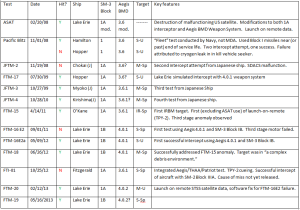The recently released FY 2014 Missile Defense Agency (MDA) budget justification documentation provides some new details on the MDA’s plans for future tests of the Ground-Based Midcourse Defense (GMD) national missile defense system. In particular, it raises the possibility of carrying out a second non-intercept flight test (CTV-02) before resuming intercept testing using the new CE-II version of the interceptor’s kill vehicle.
As discussed in my previous post on GMD testing, following the failure of the FTG-06a intercept test in December 2010, MDA removed the ten deployed Ground-Based Interceptors (GBIs) equipped with the CE-II version of the kill vehicle from operational status and suspended deliveries of new GBIs. Deliveries of new GBIs and repairs to the deployed CE-II equipped GBIs were to begin following successful completion of a return-to-intercept (RTI) flight testing program. The RTI program was to consist of a non-intercept flight test (CTV-01) which if successful would be flowed by an intercept test (FTG-06b).
The non-intercept test CTV-1 was conducted on January 26, 2013 and was described, based on preliminary information, as successful. The FY-2014 budget justification states that “Initial results indicate very robust performance of the CE-II kill vehicle.”[1]
However, the budget justification also states that: “In implementing a less concurrent technical approach for the CE-II program, we plan to execute a CTV-02 non-intercept flight test in second quarter 2014 followed by FTG-09 CE-II intercept test in fourth quarter 2014.”[2] On the other hand, the budget materials also indicated that if the success of CTV-01 was assessed to “conclusive,” then instead “we will eliminate CTV-02 in FY 2014 and instead fly the next CE-II intercept flight test (FTG-06b) in 1st quarter FY 2014, and plan to then conduct a second GBI intercept test in late FY 2014.
Note that the CTV-01 test in January was with a CE-II kill vehicle that still contained the part believed to be defective but used mitigations for the problems resulting from the part. Presumably, CTV-02, if it takes place, would use a kill vehicle with the new replacement part (as FTG-06b was planned to do).
At the Pentagon’s March 15 press conference, it was announced that an intercept test using an older CE-I kill vehicle would be conducted this summer. The budget documents state add that this test will be conducted in “in third quarter 2013 to validate reliability improvements made to the CE-I fleet over the last several years. [3] As discussed in a previous post on GBI cost, the GAO estimated that each of the original CE-I GBIs needed repairs and refurbishments that were estimated to cost between $14 and $24 million per interceptor.
Thus the GMD flight tests plans, as far as I have been able to reconstruct them (which may not be completely) now appears to be as follows (all are intercept tests except for CTV-02):
FY 2013, 4th Q: CE-I intercept test.
FY 2014, 1st Q: CTV-02 (non-intercept) or FTG-06b (intercept) test of CE-II GBI.
FY 2014, 4th Q (or FY 2015, 1st Q): FTG-09 CE-II intercept test.
FY 2015, 4th Q: FTG-11, salvo (two interceptors) test against ICBM target.
FY 2016, 4th Q: FTG-15:
FY 2017, 4th Q: FTG-13: (possibly two stage booster?)
FY 2018, 4th Q: FTO-03: Operational test with Aegis, THAAD and Patriot.
FY 2019, 4th Q: FTG-17 (possibly two-stage booster?)
FY 2021, 4th Q: FTG-12
FY 2022, 4th Q: FTG-14





